Dodge Ram
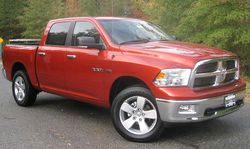 |
|
| Manufacturer | Chrysler |
|---|---|
| Production | 1981–present |
| Assembly | Saltillo, Coahuila, Mexico Warren, Michigan United States |
| Predecessor | Dodge D Series |
| Class | Full-size pickup truck |
| Layout | Front-engine, rear-wheel drive / four-wheel drive |
- This article is about the full-size truck. For other uses, such as the full-size van, see Dodge Ram (disambiguation).
The Ram (previously known as Dodge Ram) is a full-size pickup truck manufactured by Chrysler Group LLC and, as of late 2010, sold under the Ram brand. Previously, Ram was part of the Dodge lineup of light trucks.
The name Ram was first used in 1981 on the redesigned Ram and Power Ram, though it came from the hood ornament used on 1930s and '40s Dodge vehicles. The truck is in its fourth generation as of the 2009 model year.
Dodge Ram trucks have been named Motor Trend magazine's Truck of the Year three times: the second-generation Ram won the award in 1994, and the third-generation Ram Heavy Duty won the award in 2003. The fourth-generation Dodge Ram Heavy Duty won in 2010.
The Ram is currently built at Saltillo Truck Assembly in Saltillo, Coahuila, Mexico and Warren Truck Assembly in Warren, Michigan, United States.
|
1981–1993 (D/W)
 |
|
| Production | 1981–1993 |
|---|---|
| Body style(s) | 2-door 2-door extended cab 4-door crew cab Dually |
| Platform | Chrysler AD platform |
| Engine(s) | 225 cu in (3.7 L) Slant-6 I6 239 cu in (3.9 L) LA V6 318 cu in (5.2 L) LA V8 360 cu in (5.9 L) LA V8 5.9 L (~360 cu in) Cummins diesel I6 |
| Transmission(s) | 3- or 4-speed Torqueflite automatic 4- or 5-speed manual |
| Wheelbase | 2-door short bed: 115 in (2,921 mm) 2-door long bed: 131 in (3,327 mm) 4-door long bed: 165 in (4,191 mm)[1] |
| Length | 190.8 in (4,846 mm) 210.8 in (5,354 mm) |
| Width | 79.5 in (2,019 mm) |
| Height | 76 in (1,930 mm) 73 in (1,854 mm) |
| Related | Dodge Ramcharger |
The first-generation Ram trucks, named for the Ram hood ornament that first graced Dodge cars in the 1930s, was introduced in 1981.[1] Dodge kept the previous generation's model designations: "D" or Ram meant two wheel drive while the "W" or Power Ram meant four wheel drive. Similar to Ford, Dodge used 150 to indicate a half-ton truck, 250 for a three-quarter-ton, and 350 for one-tons. Standard cab, "Club" extended cab, and crew cab versions were offered along with 6.5 ft (2.0 m) and 8 ft (2.4 m) bed lengths and "Utiline" and "Sweptline" styled boxes. Externally, the first-generation Rams were facelifted versions of the previous generation Dodge D-Series pickups introduced in 1972. The new model introduced larger wraparound tail lamps, single rectangular headlamps, and squared-off body lines. The interior was updated and included a newer style bench seat, and a completely new dashboard and instrument cluster. Available engines for these trucks were the 225 cu in (3.7 L) slant six, the 318 cu in (5.2 L) V8, and the 360 cu in (5.9 L) V8 with a variety of carburetors available for each engine. Among the other options offered on the Ram were front bumper guards, a sliding rear cab window, power locks & windows, and a plowing package for the 4-wheel drive version (referred to as the Sno Commander).
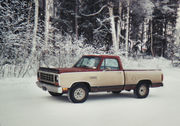
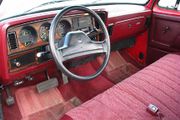
Base D100 models were added for 1984, replacing the previous "Miser" trim level available on the D150.
A "Ram-Trac" shift-on-the-fly transfer case was added for 1985's Power Rams, and both the crew cab and Utiline flared bed were dropped for 1986, also the first year for a new crossbar grille and slight front end styling changes. Engines were updated for the 1988 model year. The Slant-6 was dropped in favor of a 3.9 L (~238 cu in) fuel injected V6 with 25% more power. The 5.2 L (318 cu in) engine also received electronic fuel injection in 1988. Because electronic fuel injection was added, a computer was used to control ignition, fuel, and manage other areas of the engine and in some cases, the automatic transmission lockup function depending on the model. Inside the cab where a small compartment was once located on the dash, a new "message center" contained the check-engine light, brake warning light, and the warning light for the ABS if the truck was so equipped. Diagnostic fault codes were stored in the computer's memory, and cycling the ignition key three times would allow the computer to flash the trouble codes through the check-engine light for diagnosis of some problems.[2]
For 1989, the 5.9 L V8 also received throttle body fuel injection for a 20 hp (15 kW) gain. Rear ABS also became standard equipment. Additionally, Dodge introduced a new overdrive automatic transmission for reduced fuel consumption. This light-duty transmission was designated the A500, and was offered with the 3.9 L V6 and 5.2 L V8. An "O/D Off" pushbutton switch to lock out the overdrive 4th gear was added to the message center. The A727 automatic saw continued use for heavy duty applications.
A Cummins B Series engine was also added to the engine lineup and for the first time, Dodge saw sales go up. The Cummins could be manufactured with a heavier-duty version of the A727 automatic or a 5 speed manual transmission and was available on 250 and 350 pickups and chassis cabs. This diesel engine option was drastically different from Ford and GM diesel engines optioned at the time. The Cummins featured direct injection, where the Ford and GM diesels featured Indirect injection; this also meant the Cummins didn't have to rely on Glowplugs. The Cummins was a Straight-six engine where the GM and Ford Diesel engines were a V8 engine. Many owners considered these unique properties an advantage to the Cummins B Series engine.
The Ram 100 model designation was dropped and these models folded back into the "150" range for 1990 due to the introduction and sales success of the Dodge Dakota pickup. Additionally, the instrument cluster was slightly revised; the ammeter was replaced by a voltmeter while maintaining the 3-pod arrangement of the speedometer and gauges.
The grille was redesigned for 1991 but kept the large rectangular headlamps and crossbar appearance. The engines were substantially upgraded for 1992 (3.9L and 5.2L) and 1993 (5.9) with multi-port fuel injection, new manifolds and higher compression cylinder heads for noticeably higher output. These newly-revised engines were marketed under the "Magnum" name. A heavy-duty overdrive Torqueflite automatic transmission called the A518 was offered with the 5.2 L and 5.9 L engines. As part of Chrysler's overhaul of corporate transmission nomenclature, the A500 and A518 were redesignated 42RH and 46RH, respectively, in 1992. The initial "4" signified a 4-speed transmission, the second digit identified the transmission's relative torque capacity, the letter "R" in the third position denoted a rear-wheel drive transmission, and the final letter "H" signified hydraulic shift control. The 3-speed automatic remained available; the A727 was redesignated 36RH, and the A904, A998, and A999 became the 30RH, 31RH, and 32RH. During this time, Dodge reintroduced the Club Cab, which was equipped with fold-out jump seats. Although this added cab space, the jump seats were not very comfortable. Entry was made through the passenger or drivers doors as there were no rear doors for this configuration.
These trucks, though popular with fleets, sold poorly compared to the Ford F-Series and the General Motors C/K Trucks, with just under 100,000 units sold most years of their production. Part of this was due to the dated cab and chassis design which had been in production since 1972. Additionally, the interior had been given few updates since 1981.
Engines
| Years | Engine | Power | Torque |
|---|---|---|---|
| 1981–1987 | 225 cu in (3.7 L) Slant-6 | 95 hp (71 kW)[1] | |
| 1988–1991 | 239 cu in (3.9 L) LA V6 | 125 hp (93 kW)[1] | |
| ?1992-1991? | 3.9 L (239 cu in) Magnum V6 | 180 hp (130 kW)[1] | |
| 1981–1987 | 318 cu in (5.2 L) LA V8 | 140 hp (100 kW)[1] | |
| 1988–1991 | 318 cu in (5.2 L) LA V8[1] | ||
| 1992–1993 | 5.2 L (318 cu in) Magnum V8 | 230 hp (170 kW)[1] | 280 lb·ft (380 N·m)[1] |
| 1981–1988 | 360 cu in (5.9 L) LA V8 | 170 hp (130 kW)[1] | |
| 1989–1992 | 360 cu in (5.9 L) LA V8 | 190 hp (140 kW)[1] | |
| 1993 | 5.9 L (360 cu in) Magnum V8 | 230 hp (170 kW)[1] | 325 lb·ft (441 N·m)[1] |
| 1989–1993 | 5.9 L (360 cu in) Cummins diesel I6 | 160 hp (120 kW)[1] | 400 lb·ft (542 N·m)[1] |
1994–2002 (BR/BE)
 |
|
| Production | 1994–2001 (Ram 1500) 1994–2002 (Ram 2500 and 3500) |
|---|---|
| Body style(s) | 2-door regular cab 2-door extended cab 4-door extended cab Dually |
| Platform | Chrysler BR/BE platform |
| Engine(s) | 3.9 L Magnum V6 5.2 L Magnum V8 5.9 L Magnum V8 5.9 L B5.9 diesel I6 8.0 L Magnum V10 5.9 L ISB diesel I6 |
| Transmission(s) | 4-speed automatic 5-speed manual 6-speed manual |
| Wheelbase | 118.7 in (3,015 mm) (2-door, short bed)[1] 134.7 in (3,421 mm) (2-door, long bed)[1] 154.7 in (3,929 mm) |
| Length | 204.1 in (5,184 mm) 224.1 in (5,692 mm) 244.1 in (6,200 mm) |
| Width | 79.4 in (2,017 mm) 93.5 in (2,375 mm) (Towing mirrors) |
| Height | 77.1 in (1,958 mm) |
| Designer | Phillip E. Payne |
The Ram line was redesigned for 1994. The exterior styling was the result of design concepts by chief designer Phillip E. Payne, plus extensive customer research that revealed that full-sized pickup buyers were enamored of a strong exterior design that suggested the "look of a big rig truck".[3] Dodge Truck Product Planners recognized that while some customers would not identify with the unique design, it would mandate instant recognition for the new Dodge full-sized pickup. It featured a big rig-looking front end and a large grille and was nothing like Ford, or Chevy/GMC pickup in design. Engine offerings continued over from the first-generation ram and were the 3.9 L V6, 5.2 L V8, 5.9 L V8, and 5.9 L I6 Cummins Turbo diesel. Added to the line up was a new 488 cubic inch 8.0L V10 engine designed as an alternative for those who wanted superior pulling power but didn't want a diesel. The new V10 and Cummins Turbo diesel could only be had in the 2500 and up trucks. Models were now the 1500 half-ton, 2500 three quarter-ton, and 3500 dual rear wheel one-ton in both 2 and 4 wheel drive. 1500 Rams offered both 6 and 8-foot (1.8 x 2.4 m) boxes. 2500 Rams offered 6-foot (1.8 m) boxes only with quad cabs. 3500 Rams were only made with 8-foot (2.4 m) boxes.
Dodge offered the 2500 series in two different gross-vehicle weight ratings for the first few years but this was dropped in the late 90s. The purpose of the light duty and heavy duty 2500 trucks were for the heavy duty 2500 to take the place of the discontinued one ton single rear wheel trucks.
On the inside, special attention was paid to in-cab storage features, with a large glovebox, a center armrest storage area, and extra storage space behind the seat. The dash and gauge cluster were a far cry from the previous model Ram and was far more modern as well. A redesign of the dashboard and instrument cluster was made in 1998 along with the introduction of the quad cab, and rounded black plastic side-view mirrors replaced the previous rectangular design. The 2000 models saw the introduction of heated leather seats.
In 1998, Dodge introduced the "Quad Cab", which used smaller suicide doors in the back for a door opening. This was offered as an option on the ""Club Cab"" for the model year.
In 1999 Dodge revised the front end for the Sport models with a restyled bumper, quad-beam clear-lens headlamps, and body-color grille.
The redesigned 1994 Ram was a sales success, with sales rocketing from 100,000 units in 1993 to 240,000 in 1994, 280,000 in 1995, and nearly 400,000 in 1996. That year, it was prominently featured as the hero vehicle in the film Twister. Sales of this generation peaked at just over 400,000 in 1999 before declining against the redesigned Ford and GM trucks. By 2001, Ram sales figures were below those of Ford and Chevy trucks.
Although Dodge introduced a new Ram 1500 for 2002, the old second generation style Ram was carried over for the 2002 model year heavy-duty 2500 and 3500 trucks. The new third generation Ram would not appear in the 2500/3500 variants until 2003. Part of this delay was due to the (then-)new 5.7 L Hemi engine not being ready for production.
Drive-train
Transmissions
Transmissions for the Ram were the lower geared A500/42RH-RE for light duty applications found behind the 3.9 L V6, the A518/46RH-RE for more heavy duty applications found behind the 5.2 L and 5.9 L V8 engines, and the A618/47RH-RE for heavy duty use behind the V10 gasoline and Cummins diesel engines. The 47RH was used in 1994 and 1995 model years, while the 47RE was used from 1996 through 2002. A NV3500 was offered in 1500 Rams and light duty 2500 Rams. A NV4500 was standard in 2500 and 3500 trucks (except the uncommon, light duty 2500 rams). A NV5600 was offered in 2000 Rams and was the only transmission offered behind the High Output diesel in 2001 and 2002.
Transfer cases
There were a total of 5 Transfer cases for the four wheel drive Ram. All were part time and had a low range of 2.72:1. The 1500 featured a NV231 and NV231HD. The NV241 was standard on V8 2500 Rams. The 2500 and 3500 V10 and Diesel featured a NV241DLD from 1994-1997. In 1997 the NV241DHD became a option for all 2500 Rams and was standard on 3500 Rams from 1998-2002.
Axles
The Dodge Ram featured a wide variety of axles. For the front axle of 4x4 Rams, a Dana 44 was used on all 1500 Rams and some, early, light duty 2500 Rams, however most of the 2500 and all 3500 Rams used Dana 60 front axles. The 1500 Rams and some, early, light duty 2500 Rams used a 9.25 Chrysler axle in the rear. A Dana 60 rear axle was used on heavy duty 2500 V8 Rams. A Dana 70 rear axle was used in 2500 Rams with a V10 or a Diesel/Automatic transmission combination. A Dana 80 rear axle was used on 2500 Rams with a manual transmission and diesel engine combination and all 3500 Rams. The front solid axles in these rams were unique in the fact they didn't feature Locking hubs, but featured a Center axle disconnect. The 2002, 2500 and 3500 Rams saw the eventual phase out of the Center axle disconnect, in favor of front axles that were permanently locked in. Dodge continues to feature front axles like this for their 2500, 3500, 4500, and 5500 trucks.
Engines
A natural gas engine debuted for 1995 but was not popular and was only used in fleet vehicles on a very limited production run. The Cummins B Series engine was switched from the 12 Valve to the 24 Valve (ISB) in the middle of the 1998 model year Dodge Rams due to emissions regulations. A little over half of the 1998 Cummins Diesel powered Dodge Rams got 24 Valves over the 12 valves.
| Years | Engine | Power | Torque |
|---|---|---|---|
| 1994-2001 | 3.9 L (239 cu in) Magnum V6 | 175 hp (130 kW)[1] | |
| 1994–2001 | 5.2 L (318 cu in) Magnum V8 | 220 hp (160 kW)[1] | 295 lb·ft (400 N·m)[1] |
| 1995–1997 | 5.2 L (318 cu in) Natural Gas V8 | 200 hp (150 kW)[1] | 430 lb·ft (583 N·m)[1] |
| 1994–1997 | 5.9 L (360 cu in) Magnum V8 | 230 hp (170 kW)[1] | 325 lb·ft (441 N·m)[1] |
| 1998–2002 | 5.9 L (360 cu in) Magnum V8 | 245 hp (183 kW)[1] | 335 lb·ft (454 N·m)[1] |
| 1994–2002 | 8 L (488 cu in) [4] LA V10 | 300 hp (220 kW) hp[1] | 450 lb·ft (610 N·m)[1] |
| 1994–1995 | 5,883 cc (5.883 L; 359.0 cu in)[5] Cummins 12-valve Diesel I6 | 175 hp (130 kW) (manual), 160 hp (120 kW) (auto)[1] | 420 lb·ft (569 N·m) (manual), 400 lb·ft (542 N·m) (auto)[1] |
| 1996–1998 | 5,883 cc (5.883 L; 359.0 cu in)[5] Cummins 12-valve Diesel I6 | 215 hp (160 kW) (manual), 180 hp (130 kW) (auto)[1] | 440 lb·ft (597 N·m) (manual), 420 lb·ft (569 N·m) (auto)[1] |
| 1998–2000 | 5,883 cc (5.883 L; 359.0 cu in)[5] Cummins ISB 24-valve Diesel I6 | 235 hp (175 kW) (manual), 215 hp (160 kW) (auto)[1] | 460 lb·ft (624 N·m) (manual), 420 lb·ft (569 N·m) (auto)[1] |
| 2001–2002 | 5,883 cc (5.883 L; 359.0 cu in)[5] Cummins ISB 24-valve Diesel I6 | 235 hp (175 kW) (Standard), 245 hp (183 kW) (High Output)[1] | 460 lb·ft (624 N·m) (Standard), 505 lb·ft (685 N·m) (High Output)[1] |
 94-01 Dodge Ram Regular Cab |
Dodge Ram 3500 |
 1994 Dodge Ram 1500 4X4 |
2002–2008 (DR/DH/D1/DC/DM)
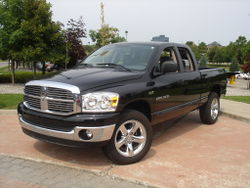 |
|
| Production | 2002–2008 (1500) 2003–2009 (2500 & 3500) |
|---|---|
| Body style(s) | 2-door Regular cab 4-door Quad cab 4-door Mega Cab Dually |
| Platform | Chrysler DR/DH/D1/DC/DM platform |
| Engine(s) |
3.7 L V6 |
| Transmission(s) | 4-speed 45RFE automatic 5-speed 545RFE automatic 6-speed 68RFE automatic 6-speed AS68RC 6-speed manual |
| Wheelbase | 204.3 in (5,189 mm) 192.3 in (4,884 mm) 188.3 in (4,783 mm) 168.3 in (4,275 mm) 144.3 in (3,665 mm) 164.3 in (4,173 mm) 120.5 in (3,061 mm) 140.5 in (3,569 mm) 160.5 in (4,077 mm) |
| Length | 295.1 in (7,496 mm) 283.1 in (7,191 mm) 279.1 in (7,089 mm) 259.1 in (6,581 mm) 255.1 in (6,480 mm) 235.1 in (5,972 mm) 207.7 in (5,276 mm) 229.7 in (5,834 mm) 249.7 in (6,342 mm) |
| Width | 79.5 in (2,019 mm) 96 in (2,438 mm) (Towing mirrors) |
| Height | 75.7-80.8 in (1923-2052 mm) |
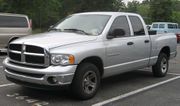

The third-generation Ram debuted for 2002 on 1500 models and 2003 on 2500 & 3500 models. This was a major update including an all new frame, suspension, power trains, interiors, and sheet metal. It included a larger grille, and special models kept interest up as most competitors had adopted the Ram's separate-fender look. The "crew cab" models for this generation were actually extended cab trucks that happened to utilize conventional-opening rear doors. The four wheel drive light trucks (1500 series) lost their live axles in favor of an independent front suspension, but the 2500 and 3500 series retained the live axles for maximum longevity and durability. This body style draws heavily from the previous generation.
The redesigned trucks bolstered sales, with 400,000 sold in 2002 and nearly 450,000 sold in 2003, a new high point for the Ram name. At the same time, both Ford and GM trucks were increasing in sales from a 2001 peak over 850,000 to the 900,000 range. But the Ram's sales could not keep up with the eleventh-generation F-150 and the new Nissan Titan in 2004 and 2005, with 400,543 Rams sold that year. Reason being primarily because Dodge did not manufacture a crew cab to compete with Ford and other manufacturers. With the introduction of the new 2007 Tundra, styled and engineered similarly to the Ram, Dodge was forced to significantly increase the incentives to keep demand up for their vehicle.
2006 Face-lift
The 2006 Dodge Ram is an updated version of the previous generation. One notable addition is the Mega Cab, featuring a 6.5-foot (2 m) cargo box and 22 inches (560 mm) of extra cab space, allowing seating for six with rear recliners. Also, a full screen mapping in-dash navigation system became an option. The headlamps have been redesigned for better performance.
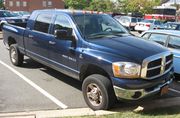
Another change for the 2006 model year was the replacement of the first version 5.7 L (345 cu in) Hemi V8 in half-ton models with the newer Multi-Displacement System Hemi V8 engine that is available in Chrysler and Dodge sedans. This engine features the same performance but has a cylinder-deactivating feature enabled under light loads to increase fuel economy by 3 MPG city and 4 MPG hwy. This new Hemi still delivers 345 hp (257 kW) and 375 lb·ft (508 N·m).
Models built after January 1, 2007 offered a new 6.7L Cummins Turbo Diesel introduced as an option in 2500/3500 models replacing the 5.9L. It produced 350 hp (260 kW)||650 lb·ft (881 N·m). Unlike the 5.9L which was backed by the 4-speed 48RE Transmission, the 6.7L was equipped with the new 6-speed 68RFE transmission.
Chassis Cab
In 2007 a 3500 Chassis Cab model was introduced, with industry standard rear frame width and wiring to accommodate outfitters. In addition to the 5.7 L (345 cu in) HEMI V8, a Cummins 6.7 L (408 cu in) diesel rated at 350 hp (260 kW) and 650 lb·ft (881 N·m) was also available. Automatic Transmissions used were the 545RFE with the 5.7 L (345 cu in) the AS68RC with the 6.7 L (408 cu in) . The G56 transmission was the only manual transmission offered.
For 2008, Dodge introduced two more Chassis Cab models, the 4500 and 5500. These are class 4 and 5 trucks with a Gross Weight of 16,500 lb (7,500 kg) and 19,500 lb (8,800 kg), respectively. Both trucks come equipped with the same version of the Cummins 6.7 L (408 cu in) diesel as the 3500 chassis cab model. Sterling, who worked with Dodge in development, has their own version called the Sterling Bullet with a unique grille. Sterling is a division of Freightliner LLC which, like Dodge, was owned by the former Daimler Chrysler.
Engines
| Model | Years | Engine | Power | Torque |
|---|---|---|---|---|
| 1500 | 2002–2008 | 3.7 L (226 cu in) Magnum V6 | 215 hp (160 kW)[1] | 235 lb·ft (319 N·m)[1] |
| 2002–2007 | 4.7 L (287 cu in) Magnum V8 | 235 hp (175 kW)[1] | 295 lb·ft (400 N·m)[1] | |
| 2008 | 4.7 L (287 cu in) Magnum V8 | 310 hp (230 kW) | 330 lb·ft (447 N·m) | |
| 2002–2003 | 5.9 L (360 cu in) Magnum V8 | 245 hp (183 kW)[1] | 335 lb·ft (454 N·m)[1] | |
| 2004–2008 | 5.7 L (345 cu in) Hemi V8 | 345 hp (257 kW)[1] | 375 lb·ft (508 N·m)[1] | |
| 2500/3500 | 2003–2008 | 5.7 L (345 cu in) Hemi V8 | 345 hp (257 kW) | 375 lb·ft (508 N·m) |
| 2009 | 5.7 L (345 cu in) Hemi V8 | 388 hp (289 kW)[1] | 404 lb·ft (548 N·m) | |
| 2003–2004.5 | 5.9 L (360 cu in) Cummins diesel I6 | 305 hp (227 kW) | 555 lb·ft (752 N·m) | |
| 2004.5–2007 | 5.9 L (360 cu in) Cummins diesel I6 | 325 hp (242 kW) | 610 lb·ft (827 N·m) | |
| 2007.5–2009 | 6.7 L (408 cu in) Cummins diesel I6 | 350 hp (260 kW) | 650 lb·ft (881 N·m) | |
| 2003 | 8 L (488 cu in) Magnum V10 | 310 hp (230 kW) | 450 lb·ft (610 N·m) | |
| Chassis Cab | 2007–2008 | 5.7 L (345 cu in) Hemi V8(3500 Only) | 345 hp (257 kW) | 375 lb·ft (508 N·m) |
| 2009 | 5.7 L (345 cu in) Hemi V8(3500 Only) | 388 hp (289 kW)[1] | 404 lb·ft (548 N·m) | |
| 2007–2009 | 6.7 L (408 cu in) Cummins diesel I6 | 350 hp (260 kW) | 650 lb·ft (881 N·m) | |
| SRT-10 | 2004–2006 | 8.3 L (505 cu in) Viper V10 | 510 hp (380 kW) | 535 lb·ft (725 N·m) |
2009– (DS/DJ)
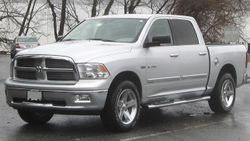 |
|
| Also called | Ram 1500/2500/3500 (2010–present) |
|---|---|
| Model year(s) | 2009 – |
| Body style(s) | 2-Door Regular Cab 4-Door Quad-Cab 4-Door Crew-Cab 4-Door Mega-Cab Dually |
| Engine(s) | 3.7 L (226 cu in) PowerTech V6 4.7 L (287 cu in) PowerTech V8 5.7 L (345 cu in) HEMI V8 6.7 L (408 cu in) Cummins Turbo-Diesel I6 |
| Transmission(s) | 4-speed automatic 5-speed automatic 6-speed automatic 6-speed manual |
| Wheelbase |
4500/5500 Crew Cab MWB: 197.2 in (5009 mm) 2WD 2500 Crew Cab SWB: 149.4 in (3795 mm) 4WD 2500 Crew Cab SWB: 148.9 in (3782 mm) 2500 Crew Cab LWB 2WD: 169.4 in (4303 mm) 2500 Crew Cab LWB 4WD: 168.9 in (4290 mm) Regular Cab 2500 : 140.5 in (3569 mm) 3500 Regular Chassis Cab: 143.4 in (3642 mm) 3500 Regular Cab LWB: 167.4 in (4252 mm) 3500 Crew Cab: 172.3 in (4376 mm) 4500 & 5500 Regular Cab LWB: 144.3 in (3665 mm) 4500/5500 Regular Cab MWB: 168.3 in (4275 mm) 4500/5500 Crew Cab SWB: 173.3 in (4402 mm) |
| Length | 4500/5500 Crew Cab MWB: 287.0 in (7290 mm) 4500/5500 Crew Cab SWB: 263.0 in (6680 mm) 4500/5500 Regular Cab Ext. LWB: 294.1 in (7470 mm) 4500/5500 Regular Cab LWB: 282.1 in (7165 mm) Crew Cab 3500: 263.0 in (6680 mm) 2500 LWB Crew Cab: Regular Cab: 209.0 in (5309 mm) Extended Cab: 226.9 in (5763 mm) Quad Cab: 229.0 in (5817 mm) Crew Cab: 227.5 in (5779 mm) 2500 Crew Cab SWB: 237.4 in (6030 mm) 2500 Crew Cab LWB: 259.4 in (6589 mm) Regular Cab 2500: 231.0 in (5867 mm) 3500 Chassis Cab: 234.1 in (5946 mm) 3500 Regular Cab LWB: 258.1 in (6556 mm) 3500 Crew Cab & 4500/5500 Regular Cab: 263.0 in (6680 mm) 4500/5500 Regular Cab: 234.1 in (5946 mm) |
| Width | 2,017 mm (79.4 in) Heavy Duty Crew Cab, 4500, 5500 & 3500: 79.1 in (2009 mm) Heavy Duty Regular Cab: 78.9 in (2004 mm) |
| Height | 73.3-73.9 (1500 4x2) 74.1-74.8 (1500 4x4) 73.3-73.7 (2500 4x2) 75.7-77.7 (2500 4x4) 78.0-78.8 (3500) 79.8-80.6 in (4500/5500) |
| Designer | Ryan Nagode, Scott Krugger |
The fourth generation Dodge Ram was introduced at the 2008 North American International Auto Show in Detroit.[6] This latest generation was sold as the 2009 Dodge Ram 1500 starting in Fall 2008. A two-mode hybrid version was planned for production, but has since been cancelled in favor of a smaller test fleet of plug-in hybrid Rams.[7]
Chrysler LLC attempted to keep the Ram competitive in the market through various developments for the 2009 model, including a new four-door cab style offering, new suspension, a new hemi engine option, and the Rambox, a new storage system that allows secure storage inside the truck’s bed walls.[8]
The 5.7 L HEMI V8's output has been increased by 45 hp (34 kW) to 390 bhp (290 kW) and 407 lb·ft (552 N·m), and fuel efficiency has been slightly increased by 4%. The 4.7 L (287 cu in) PowerTech V8 produces 310 bhp (230 kW) and 330 lb·ft (447 N·m), and the 3.7 L (226 cu in) PowerTech V6 continues with 215 bhp (160 kW) and 235 lb·ft (319 N·m).[9]
Cab options
The Mega Cab option will be deleted, at least on the 1500 series, replaced by a true four door crew cab.[10] Other cab options are regular cab and quad cab. The mega cab option remains on the 2500/3500 models.
Handling
A coil spring rear suspension replaces the leaf-springs for the 1500 model, a move to improve ride quality and handling. The payload capacities have not been negatively affected despite the massive change in suspension, but still trail those of the newer Ford F-150, Chevrolet Silverado 1500 and GMC Sierra 1500.
Payload capacities
The 2009 model's towing capacity was originally rated 9,100 lb (4,100 kg) for 2WD Ram 1500 with regular cab, long-bed, 5.7L HEMI engine, 3.92 differential and 17-inch wheels; but the rating increased to 10,450 lb (4,740 kg) without changing the setup, via the new SAE testing standard.[11] For 2010 model, payload was increased by 50 lb (23 kg) to 1,900 lb (860 kg) for regular cab 2WD model with 3.7L V-6 engine.[12]
Towing capacity for the regular cab Ram 1500 with 3.21 differential is rated at 6,100 lb (2,800 kg) with 17-inch wheels (5,900 lb (2,700 kg) with 19-inch wheels). Crew Cab and Quad Cab models are rated at 5,700 lb (2,600 kg) and 5,800 lb (2,600 kg) respectively.
Gross Combined Weight Ratings is 11,000 lb (5,000 kg) for all Ram 1500s with 3.21 axles; max 15,500 lb (7,000 kg) for 2WD Ram 1500 with long bed, 5.7L HEMI engine, and 3.92 differential.
Heavy Duty Chassis Cabs (2010-)
Chassis Cab versions were made for the Ram 3500, 4500, and 5500 models.
Engine choices include 5.7L HEMI V-8 rated 383 bhp (286 kW)@5600 rpm and 542 N·m (400 lb·ft)@4000 rpm for Ram 3500, 6.7L Cummins turbo diesel rated 350 bhp (260 kW)@3013 rpm and 880 N·m (650 lb·ft)@1500 rpm for Ram 3500 (optional), 4500, 5500.
Transmission choices include standard 6-speed manual or optional 6-speed Aisin automatic. Both transmissions support Power Take Off.
Each model has regular or crew cab, single-rear-wheel or dual-rear-wheel (3500 and up only), 4 cab-axle lengths (60, 84, 108 and 120 inches) for 4500/5500 or 2 cab-axle lengths (60 and 84 inches) for 3500, and three trim levels (ST, SLT and Laramie).
The Ram 3500 includes 2 axles with 3 axle ratios (3.42, 3.73 and 4.10) and 17-inch wheels, while Ram 4500/5500 have 1 axle with 3 axle ratios (4.10, 4.44 and 4.88) and 19.5-inch wheels. The 4500/5500 Rams rear axle is a Dana S 110. The front axle on 4x4 models is manufactured by Magna, while 2 wheel drives models just have a solid, non-drive axle.
The vehicle was unveiled at the 2009 Chicago Auto Show.[13]
Safety
The Ram comes standard with four-wheel anti-lock disc brakes, side curtain airbags, and electronic stability program or ESP. In IIHS crash tests the Ram received a Good overall score in the frontal crash test, and a Marginal score in the side impact test.[14] It received a 5 star frontal crash test rating from the NHTSA.[15]
Production
The Ram 2500 and 3500 are built in Chrysler's Saltillo Assembly Plant in Coahuila, Mexico, and the Ram 1500 is built at the Warren Truck Assembly Plant in Warren, Michigan. The Ram 1500 was also assembled at the Saint Louis Assembly plant in Fenton, Missouri before the plant was permanently closed in July 2009.[16]
Special Rams
In addition to factory equipment and appearance packages, the Ram pickup has also been offered at times with dealer-installed packages.
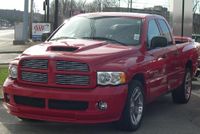
- SRT-10 also known as the Viper Ram - This is a regular or quad-cab body with the Dodge Viper's V10 engine 8.3L, 22" wheels and Pirelli tires, lowered suspension, bucket seats, body modifications, and a spoiler. The 2004 version was available only in a single cab with a 6 speed manual transmission with a Hurst shifter. For 2005, Dodge released a Quad Cab version of the Viper V10 powered truck with the 48RE four speed automatic transmission from the Ram with the Cummins turbodiesel engine. In 2004, the truck held the Guinness record of "World's Fastest Production Pickup Truck" of 154.587 mph (247.3 km/h)[17] This record stood until bettered by the Australian Holden Special Vehicles Maloo R8 in May 2006.[18] SRT-10 production ended on June 30, 2006.
- Power Wagon - This model, introduced for 2005, is an off-road focused version of the Ram. The name is drawn from Dodge's line of 4-wheel-drive trucks made from the early 1940s through the 1980s. It comes with the 5.7 L (345 cu in) Hemi engine, electronic locking differentials, electronic solenoid disconnecting sway bars, 33" off-road tires, handlebar, fender flares, "Hemi" nameplates instead of the standard Ram badging, and a 12,000 pound winch.[19] This truck is built on the 2500 platform.

- Rumble Bee - The Rumble Bee package was a limited sport-truck version of the Ram. It was available only on regular cab/short-box pickups; however, some other versions of the Ram were modified to look like Rumble Bees. It included lower body cladding, 20" wheels, a hood scoop, and a specially-trimmed interior including a serialized number plate. On the rear of the box was a stripe with a "Rumble Bee" emblem, similar to that of the Super Bee. All Rumble Bees were either black with yellow trim or yellow with black trim.
- HemiGTX - The Hemi GTX package was a limited sport-truck version of the Ram. Introduced in 2004 and only made in 2004 and 2005 these were customized by LA West of Indiana as ordered from dealers. It was available on regular cab/short-box and quad cab/short-box and 2x4 and 4x4 model pickups and included a custom overall paint from Mopars Impact colors from the 1970s (this included Hemi Orange, Plum Crazy Purple, Sublime Green,and Banana Yellow), 20" American Racing Motto chrome wheels, a new cowl "blacked out" hood, and a specially-trimmed leather 2-tone interior including a serialized number plate on the drivers side door jamb. On the sides was a "hockey stick" stripe with "HEMI GTX" and extended from the hood to the rear of the box. The air box was also painted to match the body color and a color matched steering wheel was added. They only made 433 in 2004 and roughly the same amount in 2005. A certificate of Authencity was given to all original owners.
- HemiSport - The HemiSport Edition was the Quad Cab version of the Rumble Bee, and was introduced in 2004. It was available in black, red or silver, and with either rear-wheel drive or four-wheel drive. It was equipped similarly to the Rumble Bee, but without the number plaque. The HemiSport was discontinued for 2006.
- Daytona - Introduced for 2005, the Ram Daytona is a new sport-truck edition of the Ram. It is available as a 5.7 liter Hemi V8 in Regular or Quad-Cab styles and features lower body cladding, 20" chrome wheels, SRT-10 hood, Borla dual exhaust, serialized number plate, and a tall rear spoiler reminiscent of the 1969 Dodge Charger Daytona. The Daytonas have a black body stripe to match the rear spoiler and come in Silver or "Go Mango" paint with matching interior trim. The Dodge Ram Daytona has a 3.92 ratio rear end, the same rear end as the Dodge Ram Rumble Bee. Several exterior items were unique to the Daytona package which made it different than other equipment packages. Two exterior colors were available: silver and "Go ManGo!", a metallic orange color reminiscent of the Dodge's "high impact" colors from the 1960s and 70s. It was equipped with 20-inch (510 mm) chrome rims and performance tires. Replacing the standard hood is one with a non-functional hood scoop. The most noticeable item is the large spoiler which is attached at the rear of the cargo box. The 11-inch (280 mm) spoiler lines up with the flat black stripe that runs along the back of the bed side with the word 'Daytona' written in the middle. This spoiler is reminiscient of the 1969 Dodge Charger Daytona.
- Prospector - Throughout the 80s, this package was available for the Ram pickup. In the early 80s a special badge was affixed to the box side of the truck, but this was dropped in the mid 80s. Prospector was a package that usually included a different fuel tank, cloth seat and carpeting. In the later 1980s, a light package as well as the large 6x9 mirrors were added to the list of options. This trim package was carried on until the redesign in 1994.
- Sno Commander - known as the Sno-Fighter in the older D series trucks, the Sno-Commander came with 4-wheel-drive and the V8 engine as standard equipment. It included a snow plow, heavy duty cooling, a larger battery, and provisions on the engine to hook up hydraulics to work the plow as well as a cab controller. Early model Rams also had a badge on the box side. This package was discontinued after the redesign in 1994, but a similar package is offered through Chrysler called the Snow-Plow Prep package.
- Spirit Of '76 - A special package available in 1976 to celebrate America's Bicentennial. It came with a special decal that ran down the side of the truck and cloth or vinyl interior.
- NightRunner - 2000 of these were assembled from January 2006 to December 2006. The NightRunner trim includes 20-inch (510 mm) black chrome rims, the 5.7 L (345 cu in) Hemi engine, dark shaded headlamps, NightRunner graphics, and the NightRunner logo on the speedometer.
- Limited Edition Indy Pace and SS/T pkg - The Dodge Ram Indy Pace Truck was available in 1996. It included longitudinal stripes similar to those on the Dodge Viper along with an optional door sticker stating "Official Truck of the 80th Indianapolis 500." These trucks had a 5.9 L (360 cu in) engine with upgraded exhaust and 15 hp (11 kW) more power. These also included 17-inch (430 mm) wheels with Goodyear Eagle II tires, size 275/60R-17. The SS/T (Super Sport Truck) version was available from 1997–1998 and included all the same upgrades except the door sticker. The SS/T also had "SS/T" designed into the stripe on both the hood and tailgate. The Indy Trucks were available only in blue with white stripes. The SS/Ts were available in white/blue, red/silver, black/silver, and green/silver. All include a specialty sticker on the inner door stating, "Built with pride in the U.S.A." A real Pace truck is a metal plate on the driver's side frame rail, with a raised number 19 on it. However, the SS/Ts do not have this.
- Dodge Ram R/T - It is a concept with blue body, 22-inch forged wheels, SRT stripes, new front bumper with chin spoiler. It was unveiled in 2008 SEMA show.[20]
Dodge announced a hybrid version of the Ram, dubbed the Contractor's Special, in 2003. However, the schedule for delivery slipped as Dodge backed away from the vehicle. The hybrid Ram was available only for fleet purchasers (if at all) and did not enter mass production. It offered an AC electrical outlet panel for running an entire job site worth of power tools, but the through-the-road method of balancing the gas engine and electric motor reportedly did not work as desired. Dodge has announced that it will use a hybrid transmission developed jointly with General Motors and BMW.[21]
Total American sales
| Calendar Year | Sales |
|---|---|
| 1999[22] | 428,930 |
| 2000 | 380,874 |
| 2001[23] | 344,538 |
| 2002[24] | 396,934 |
| 2003 | 449,371 |
| 2004[25] | 426,289 |
| 2005 | 400,543 |
| 2006[26] | 364,177 |
| 2007 | 358,295 |
| 2008[27] | 245,840 |
| 2009[28] | 177,268 |
References
- ↑ 1.00 1.01 1.02 1.03 1.04 1.05 1.06 1.07 1.08 1.09 1.10 1.11 1.12 1.13 1.14 1.15 1.16 1.17 1.18 1.19 1.20 1.21 1.22 1.23 1.24 1.25 1.26 1.27 1.28 1.29 1.30 1.31 1.32 1.33 1.34 1.35 1.36 1.37 1.38 1.39 1.40 1.41 1.42 1.43 1.44 1.45 John DiPietro. "Dodge Ram - Generations". Edmunds.com. Archived from the original on 2008-08-01. http://web.archive.org/web/20080801102809/http://www.edmunds.com/insideline/do/Features/articleId=46028. Retrieved 2008-09-07.
- ↑ "Retrieving fault codes". Allpar. http://www.allpar.com/fix/80s-codes.html.
- ↑ "U.S. Patent D396,828 - Body Styling of 1994 Dodge Ram". United States Patent and Trademark Office. August 11, 1998. http://patft.uspto.gov/netacgi/nph-Parser?Sect1=PTO2&Sect2=HITOFF&p=1&u=%2Fnetahtml%2FPTO%2Fsearch-adv.htm&r=29&f=G&l=50&d=PTXT&S1=%22dodge+ram%22&OS=%22dodge+ram%22&RS=%22dodge+ram%22.
- ↑ http://www.media.chrysler.com/dcxms/assets/attachments/08192002_VIPER_OVERVIEW.pdf
- ↑ 5.0 5.1 5.2 5.3 [1]
- ↑ Bill Vlasic (January 14, 2008). "Ford and Chrysler Unveil Their Redesigned Pickups ", The New York Times.
- ↑ "Chrysler Kills the Production 2011 Ram Hybrid. Will Make a Demonstration-Fleet Plug-In Version". Edmunds InsideLine. 2010-03-22. http://blogs.insideline.com/straightline/2010/03/chrysler-kills-the-production-2011-ram-hybrid-will-make-a-demonstration-fleet-plug-in-version.html.
- ↑ NAIAS 2008: Pick-Up Trucks Debut Amid Green Technologies. Global Insight (January 14, 2008).
- ↑ "Detroit 2008: 2009 Dodge Ram breaks through the gate", Autoblog.com (January 12, 2008).
- ↑ "2009 Dodge Ram - Auto Shows". Car And Driver. January 2008. http://www.caranddriver.com/autoshows/14499/2009-dodge-ram.html.
- ↑ Dodge increases towing capacity of 2010 Ram on paper with no hardware changes
- ↑ Update 1: 2010 Dodge Ram 1500 Towing Rating Increases
- ↑ Chicago 2009: Dodge Ram 3500HD
- ↑ "IIHS-HLDI: Dodge Ram 1500". Iihs.org. http://www.iihs.org/ratings/ratingsbyseries.aspx?id=401. Retrieved 2009-09-26.
- ↑ "2009 Dodge Ram 1500 Regular Cab". SaferCar.gov. http://www.safercar.gov/portal/site/safercar/menuitem.db847bd57e3dc1f885dfc38c35a67789/?vgnextoid=c95df2905bf54110VgnVCM1000002fd17898RCRD. Retrieved 2009-07-19.
- ↑ "Deal's first steps begin - Chrysler will sell its assets to Fiat; five plants to close". Associated Press. May 2, 2009. http://www2.journalnow.com/content/2009/may/02/deals-first-steps-begin/business/. Retrieved May 2, 2009.
- ↑ "Dodge Ram SRT-10 is World's Fastest Production Truck". About.com: Trucks. http://trucks.about.com/cs/2004dodgetrucks/a/gaughn_srt10.htm.
- ↑ "HSV sets new World Land Speed Record for Pickup/Utility truck". HSPN News. June 28, 2006. http://news.hspn.com/articles/519/1/HSV-sets-new-World-Land-Speed-Record-for-PickupUtility-Truck/Page1.html. Retrieved 2010-05-12.
- ↑ "Dodge Power Wagon - Off Road Truck". 4 Wheel Drive & Sport Utility Magazine. August 2007. http://www.4wdandsportutility.com/features/0807_4wd_dodge_ram_power_wagon_off_road_truck/index.html.
- ↑ Detroit 2009: Dodge Ram R/T Accessorized
- ↑ "Specialty Dodge Rams". Allpar. http://www.allpar.com/model/ram/special-rams.html.
- ↑ "Chrysler Group Announces Year-End and December Sales". Theautochannel.com. http://www.theautochannel.com/news/press/date/20010103/press033497.html. Retrieved 2009-09-26.
- ↑ "Chrysler Group Reports U.S. December Sales". Theautochannel.com. 2003-01-03. http://www.theautochannel.com/news/2003/01/04/152240.html. Retrieved 2009-09-26.
- ↑ "Chrysler Group Reports December 2003 Sales Increase of 2 Percent". Theautochannel.com. http://www.theautochannel.com/news/2004/01/05/175827.html. Retrieved 2009-09-26.
- ↑ "Chrysler Group 2005 U.S. Sales Rise 5 Percent, Highest Since 2000; December Sales Decline In Line with Overall Industry". Prnewswire.com. http://www.prnewswire.com/cgi-bin/stories.pl?ACCT=104&STORY=/www/story/01-04-2006/0004242655&EDATE. Retrieved 2009-09-26.
- ↑ "Total Chrysler LLC December 2007 Sales Up 1 Percent on the Strength of Retail; Demand...". Reuters. 2008-01-03. http://www.reuters.com/article/pressRelease/idUS217066+03-Jan-2008+PRN20080103. Retrieved 2009-09-26.
- ↑ "Chrysler LLC Reports December 2008 U.S. Sales". News.prnewswire.com. http://news.prnewswire.com/DisplayReleaseContent.aspx?ACCT=104&STORY=/www/story/01-05-2009/0004949198&EDATE=. Retrieved 2009-09-26.
- ↑ "Chrysler Group LLC December 2009 Sales". CheersandGears.com. http://www.cheersandgears.com/topic/50556-chrysler-group-llc-december-2009/. Retrieved 2010-01-05.
External links
- "A Dodge Ram History". Edmunds.com. http://www.edmunds.com/reviews/generations/articles/46028/article.html. Retrieved April 8 2005.
| Type | 1970s | 1980s | 1990s | 2000s | 2010s | |||||||||||||||||||||||||||||||||||||
| 0 | 1 | 2 | 3 | 4 | 5 | 6 | 7 | 8 | 9 | 0 | 1 | 2 | 3 | 4 | 5 | 6 | 7 | 8 | 9 | 0 | 1 | 2 | 3 | 4 | 5 | 6 | 7 | 8 | 9 | 0 | 1 | 2 | 3 | 4 | 5 | 6 | 7 | 8 | 9 | 0 | 1 | |
| Mid-size crossover | Journey | |||||||||||||||||||||||||||||||||||||||||
| Compact SUV | Raider | Nitro | ||||||||||||||||||||||||||||||||||||||||
| Mid-size SUV | Durango | |||||||||||||||||||||||||||||||||||||||||
| Full-size SUV | Ramcharger | Ramcharger | Ramcharger | Durango | Durango | |||||||||||||||||||||||||||||||||||||
| Coupe utility | Rampage | |||||||||||||||||||||||||||||||||||||||||
| Compact pickup | D-50 | Ram 50 | Ram 50 | |||||||||||||||||||||||||||||||||||||||
| Mid-size pickup | Dakota | Dakota | Dakota | |||||||||||||||||||||||||||||||||||||||
| Full-size pickup | D Series | D Series | Ram | Ram | Ram | Ram | ||||||||||||||||||||||||||||||||||||
| Ram SRT-10 | ||||||||||||||||||||||||||||||||||||||||||
| Minivan | Caravan | CV/GCV | CV/GCV | CV/GCV | CV/GCV | Grand Caravan | ||||||||||||||||||||||||||||||||||||
| Van | A100 | Tradesman | Ram Van/Ram Wagon | Ram Van/Ram Wagon | ||||||||||||||||||||||||||||||||||||||
| Sprinter | Sprinter | |||||||||||||||||||||||||||||||||||||||||
|
||||||||||||||||||||||||||||||